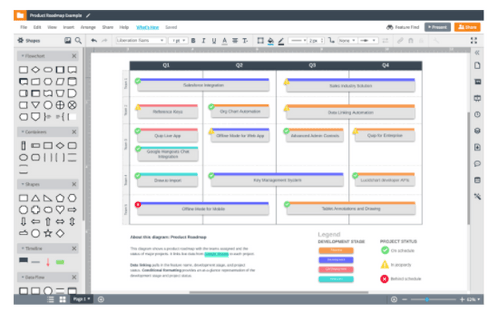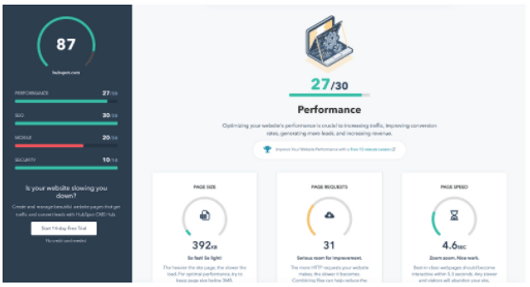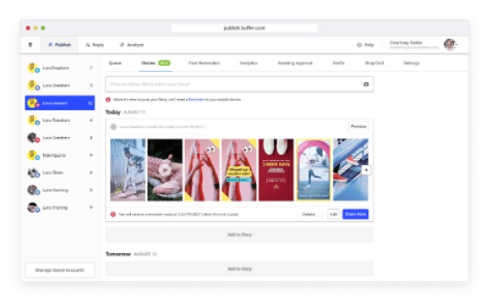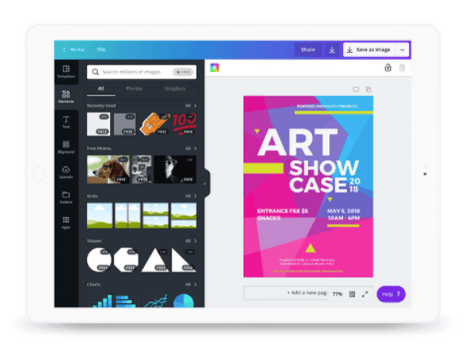5 Lightweight Tools for Modern Marketers
If this year in marketing had a theme, it would be “Doing more with less.” Not only is there pressure to produce greater ROI, we need to ensure that we’re executing on that work in the most efficient way possible.
Thankfully, gone are the days of having to purchase expensive software licenses, download bulky applications, and sit through hours of training. A cache of lightweight tools have disrupted their respective fields to offer you easy avenues to complete, present, and promote your marketing programs. Here’s five of our favorites!
1. Canva
Canva is a graphic design tool with a simple drag-and-drop interface. For any type of medium you need to create a graphic for — an Instagram post, a blog header, an email, an icon, or more types of content — Canva has a template and a host of assets at your disposal. Image source.
Our Favorite Feature: Thousands of Templates
What makes this the perfect lightweight tool are the many thousands of free templates that you instantly have access to. These templates have already been professionally designed — so, combined with Canva’s interface, they ensure that any marketer can produce quality work with just a few clicks.
Further Key Features
- An easy-to-understand user experience with its drag-and-drop interface
- The ability to upload your own logo or images and merge them with provided templates
- A large knowledge base of free video tutorials if you want or need to dive deeper into graphic design
Cost
Base Version: Free
Paid (But Worthwhile and Affordable) Version: $12.95 per Month (Pro Plan)
As with all the tools in this article, you can sign up for a free version of Canva and benefit from all the above features. But for just a few dollars per month, you can get access to more templates, a huge cache of free stock photos, and a built-in feature to create and save brand kits and templates for your team.
2. Lucidchart
Lucidchart is your gateway to bringing brainstorms, project plans, and processes to visual life. It’s a diagramming tool that allows you to jump in and sketch out a flowchart or wireframe using their drag-and-drop interface; or, start from Lucidchart’s many templates as a base.

Our Favorite Feature: It’s the Templates Again
At this point, you’ll notice a theme. A key feature of lightweight tools are their ability to save you time (by being able to jump in without the need for training) and resources (by cutting out a need for a dedicated person on your team to own the process). Professional-grade templates fit that need every time. As with Canva, there’s plenty of great options in Lucidchart to kickstart your diagram — whether it’s a user experience flow, an internal marketing process, a product roadmap, or even a website architecture.
Further Key Features
- Existing integrations with many other tools in your tech stack (think G Suite, Atlassian, or Slack)
- The ability for multiple users to work on a diagram or add comments inside the document
- Easy export features so when you’ve created your masterpiece, you can export into a PDF, .png, or a multitude of other file types for easy sharing
Cost
Base Version: Free
Paid (But Worthwhile and Affordable) Version: $7.95 per Month (Individual Plan)
Going one tier up from the free version of Lucidchart unlocks a lot of functionality. You’ll bring up the number of editable documents you can have from 3 to entirely unlimited, get access to thousands more templates, and gain the ability to automatically generate diagrams from data inputs.
3. HotJar
In the past, you’d have to pay a dedicated research firm to conduct expensive user experience studies on your website to understand how users are actually engaging with your digital presence. Today, you can do that with Hotjar by installing a single piece of code.

Our Favorite Feature: The Heatmaps
It would be impossible to overstate the value of a HotJar heatmap. This view inside the tool lets you see which CTAs users are actually clicking on, what parts of pages are getting the most attention, and how far users are actually scrolling down. With this data in hand, you can optimize CTA placements and modify your website to ensure you’re extracting the most value.
Further Key Features
- The ability to play back video recordings of different user experiences. Getting a play-by-play of how different people actually use your website is invaluable, as you’ll be able to pick up on areas of interest (and friction) that heatmaps alone may not suggest
- A tool to add user surveys to your website to gather data directly from site visitors to get context behind their actions
Cost
Base Version: Free
Paid (But Worthwhile and Affordable) Version: $39 per Month (Personal Plus Plan)
This Plus Package ups the number of page views you can collect from 2,000 to 10,000 a day. It also includes 20 times more recordings in each snapshot report when you sample your traffic.
4. HubSpot Website Grader
While Hotjar can give you insight into how to optimize the user experience, HubSpot Website Grader is your litmus test for how well your website is currently working from a technical and SEO perspective. The tool will churn out quantitative results for each area of your website, breaking them down into the various components it’s grading you on.

Our Favorite Feature: The Absolute Ease of Use
This is probably the most lightweight tool on this list because you’ll go from seeing the HubSpot Website Grader for the first time to getting results in literal seconds. Where do you need to direct resources to improve the technical elements of your website this quarter? Try it right now and you’ll know.
Further Key Features
- Return separate grades for your website’s performance, SEO, mobile-specific performance, and security
- Get simply-stated recommendations on how to improve in each necessary area
- Be pointed toward relevant free learning resources provided by HubSpot around how to improve your website’s performance and implement best practices for SEO
Cost
The One and Only Version: Free
5. Buffer
If you’re trying to wrangle your social media posting schedule for all of your accounts, Buffer is the answer. Once you link them to Buffer, you can use the tool to pre-schedule content separately to each one and manage a complete view of how you’re engaging with audiences across your full social presence.

Our Favorite Feature: The Calendar View
Buffer’s Calendar View shows you all your scheduled posts laid out in the typical calendar format (by week or by month). We appreciate this visual as it helps our clients understand their currently-planned cadence of content. If there are stretches of heavy or light days, we can shuffle posts as needed to ensure we're connecting with their audiences more regularly.
Further Key Features
- Write one post to publish to multiple social media accounts simultaneously or craft custom content for each to schedule
- Collaborate on content with multiple users prior to scheduling, with every person on your team having the same full view of your organic social channel
Cost
Base Version: Free (Note: You can access the free version of Buffer after electing to remain on a free plan at the end of a trial)
Paid (But Worthwhile and Affordable) Version: $15 per Month (Pro Plan)
The first paid version of Buffer nets you up to 8 social media channels and the ability to take full control of your posting for a good period, with 100 scheduled posts. Compare this to the free version, which allows 3 social channels and 10 scheduled posts at a time.
Lightweight Tool Takeaways
All of these tools are the perfect lightweight answer to problems you’re facing today. None of them require any installation, they can be used with zero background or experience, and they all have free versions — though we highly recommend taking advantage of the paid versions if you can!
If you think you’d benefit from working with an expert who uses these tools regularly and has the experience needed to slot them into your current marketing process, let’s chat.


 (
(

